This is one of the most common species of mushrooms in the forest, and they make themselves very hard to miss. There’s a good chance you’ve encountered Xeromphalina mushrooms in the woods, no matter where you are in North America. They are among some of the most commonly photographed species simply because they fruit in astounding numbers.
These mushrooms can turn old tree stumps into vast and beautiful displays of golden trumpets! Xeromphalina species form dense clusters on decaying wood, and their tiny caps look like little fairy umbrellas.
This detailed guide covers the most common North American Xeromphalina species, including ways to tell them apart when possible.
- Scientific Name: Xeromphalina
- Common Names: Golden Trumpet, Fuzzy Foot,
- Habitat: Decaying wood
- Edibility: Inedible
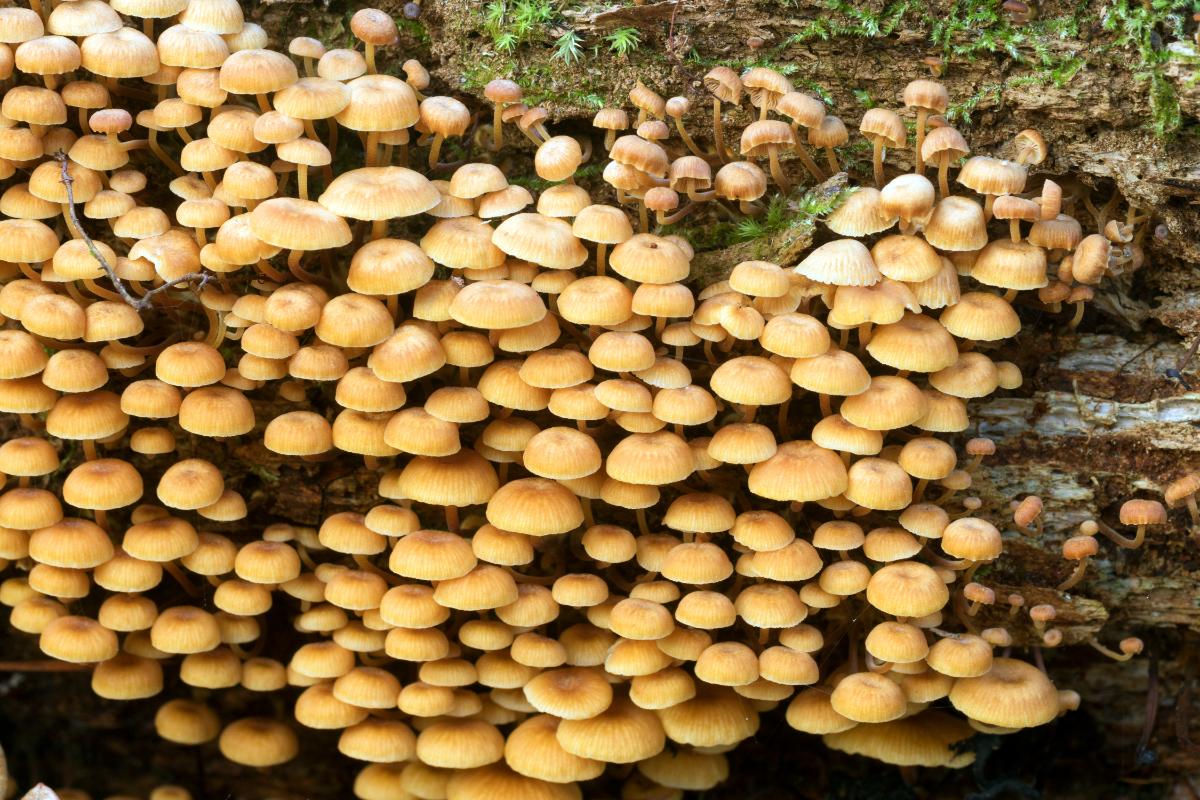
Jump to:
All About Xeromphalina Species – The Trumpets of the Forest
Xeromphalina belongs to the family Mycenaceae, and there are approximately 30 species in this family. These mushrooms are known for their huge fruiting colonies that take over logs, stumps, and sticks.
The scientific name Xeromphalina is from the Greek and means “little dry navel.” This is a reference to the distinctive depression that forms in the center of the mature cap, which looks a lot like a belly button.
Xeromphalina species have small umbrella-shaped caps. The caps are typically not more than an inch across. As they mature, the cap expands and rises at the edges while remaining depressed in the center. The mushrooms have very thin brown stems and often have very fine hairs all over their stem or at the base. Xeromphalina species have a white or buff spore print.
These mushrooms are primarily saprobic, which means they obtain nutrients by decomposing dead organic matter. They’re widely distributed across North America.
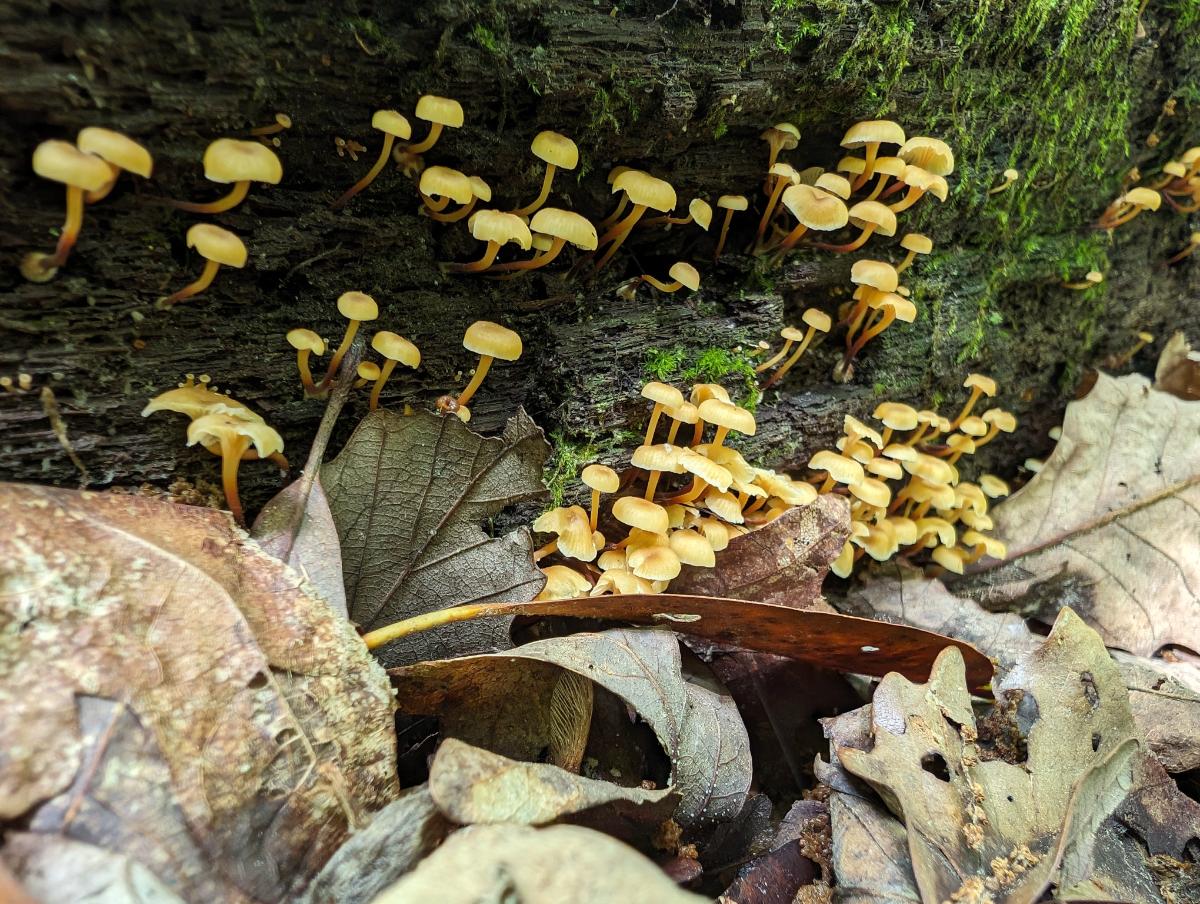
Identifying A Xeromphalina Mushroom
Overall, it’s pretty easy to determine if you’ve found an Xeromphalina species. They are quite distinctive as a group, even among the many other small brownish mushrooms that grow in the forest. While each species has its own specific traits, they all share some common features.
Cap
The caps start bell-shaped. As they grow, they spread out to become wider bells or flatten almost completely. Many of the species have caps with sunken centers. Most caps aren’t more than 1 inch across — these are very small mushrooms! Some species get a little bit wider but rarely more than 2 inches across.
The coloring on the caps of most species is some form of yellow, orange, brown, or yellowish-brown. Often, the center of the cap is a darker color than the edges. And the edges of the caps have clear striations (vertical lines) that are especially noticeable when the caps are wet.
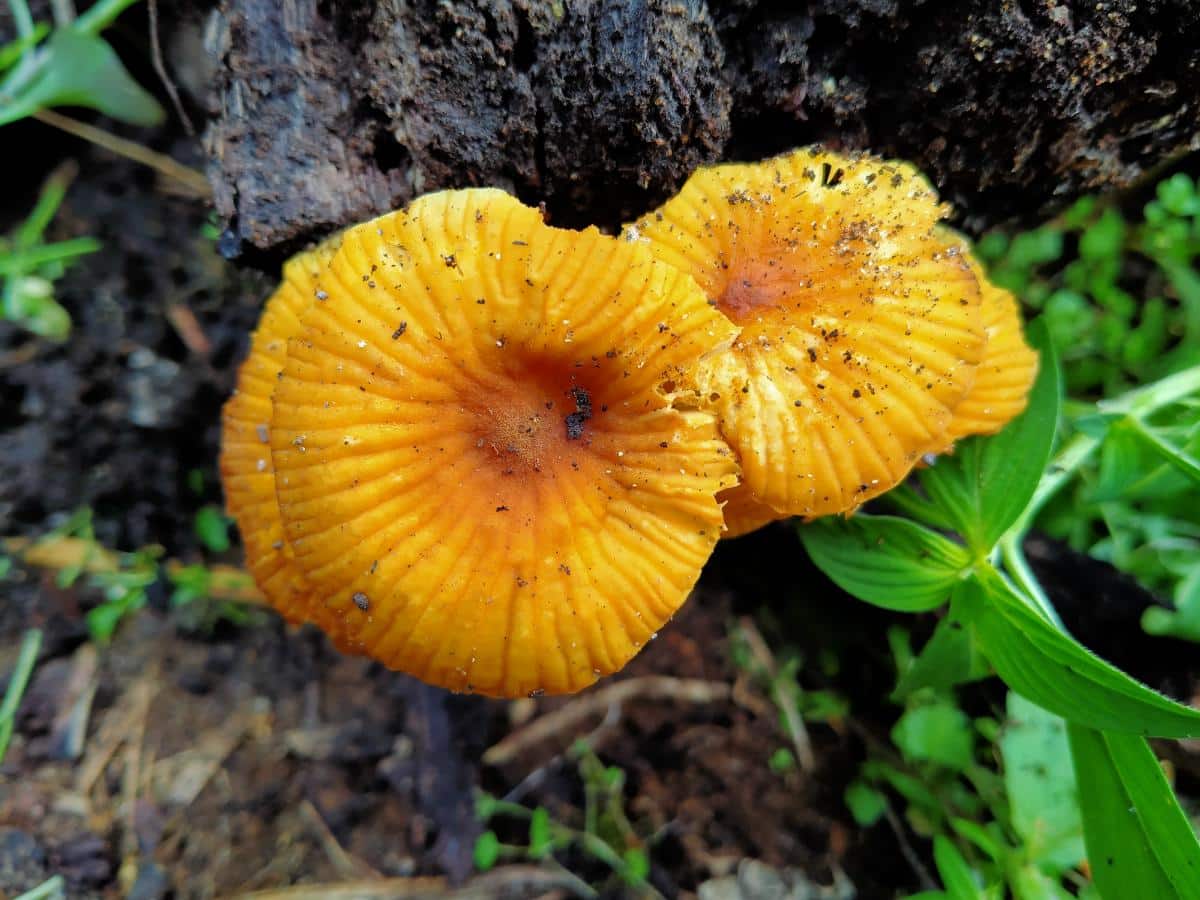
Stem
Xeromphalina species have stems that are thin and tough. Their slenderness makes them look delicate and graceful. The stem is always darker than the gills and usually darker than the cap.
Many stems of these mushrooms are very dark brown to black. This creates a very noticeable and beautiful color contrast between light-colored gills and very dark stems. In addition, the stems might be lighter colored near the top and darker lower down. The stems are either covered entirely with very thin fibrous hairs or have these hairs just at the base of the stem.
Gills
The gills of most these species have prominent cross-veins that connect adjacent gills. This creates a netted pattern that is relatively uncommon among mushrooms.
While the coloring does vary among species, they’re typically bright yellow to orange to buff. In most species, the gills are slightly decurrent. This means they extend down the stem a little bit. Also, in most species, the gills are widely spaced rather than densely packed.
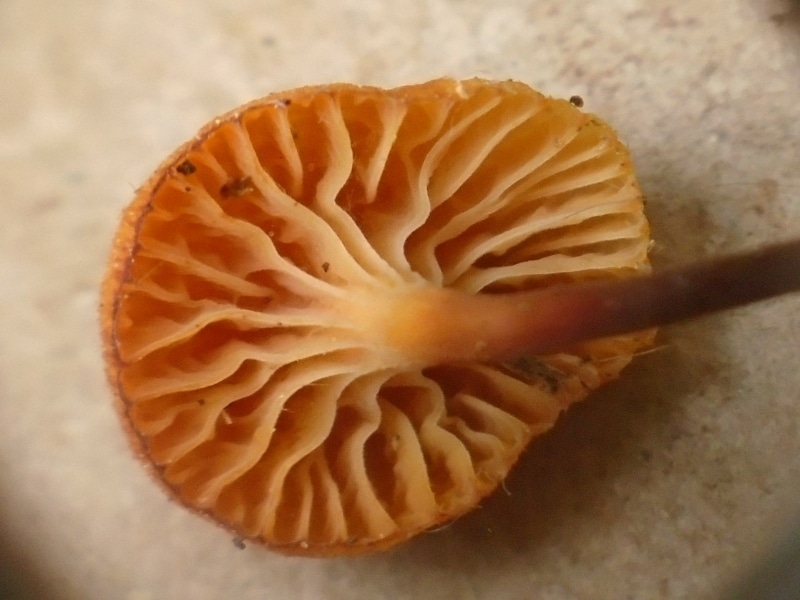
Xeromphalina campanella by Dave W on Mushroom Observer
Spore Print
Most species have white to cream to buff-colored spore prints.
Growth Pattern
These mushrooms form thick clusters on stumps and logs where moisture levels stay high. A single stump can support hundreds of these mushrooms when conditions are right. They can grow alone, but it is more common (and noticeable to the hiker) that they form massive troops that take over entire stumps.
Most grow on decomposing conifers, but there are some that fruit on hardwoods, too. They do not grow from the ground or from living wood.
How To Identify Xeromphalina
- Growing on decomposing wood
- Fruiting in huge numbers, often in the hundreds
- Thin-fleshed caps that are brownish, yellowish, or orangish
- Slender, wiry stems that are darker than the cap and gills, often dark-brown to black with age
- Thin fuzzy hairs on the entire stem or just at the base of the stem
- Gills that run down the stem slightly
- Cross-veined gills
- Whitish spore print
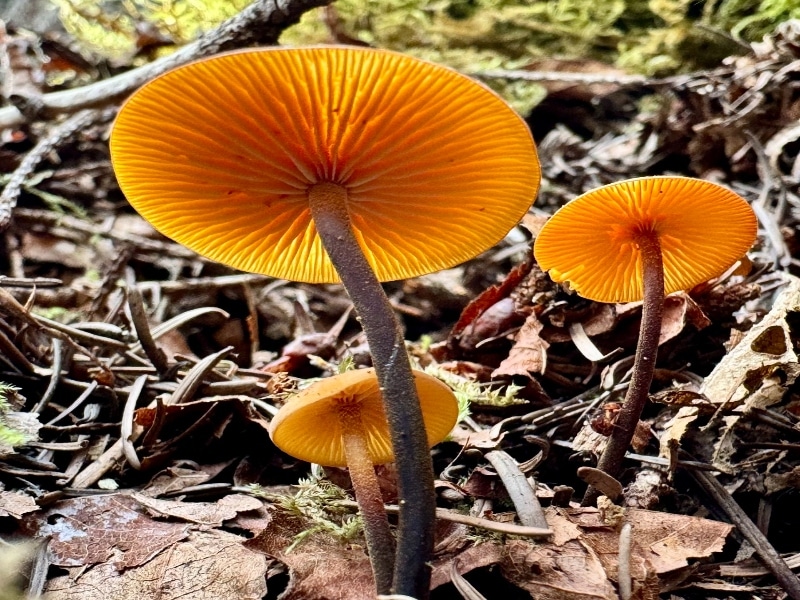
Heimiomyces fulvipes by Steve on Mushroom Observer
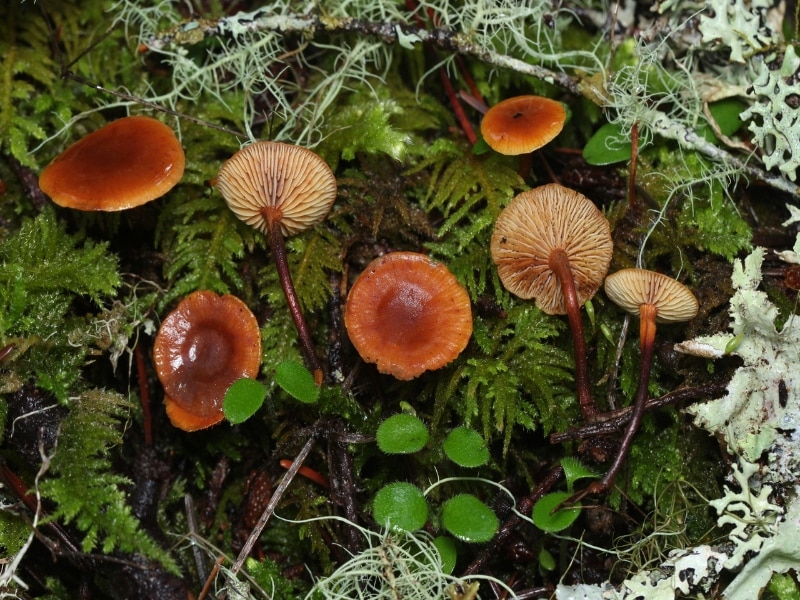
Xeromphalina by Mohannah Singh on Mushroom Observer
9 Key Xeromphalina Species in North America
North American forests are home to quite a few Xeromphalina species. Each species has its own characteristics and habitat priorities. While these are not the only Xeromphalina species here, they are the most common.
Xeromphalina campanella group (Golden Trumpets)
The golden trumpet has a small umbrella-shaped cap that is less than an inch wide. The mushroom’s outer cap expands and rises as it matures and creates a navel-like depression. Caps of this mushroom range from yellowish to brownish to orange.
The stem is yellow at the top and reddish-brown below. The stem averages 1-2 inches long. At the base of the stem, there are brown or yellow hairs. The gills of the golden trumpet are pale yellow to pale orange and run a little bit down the stem. The gills are often connected by many cross-veins, a key identifying characteristic.
This tiny mushroom typically fruits in dense clusters (sometimes hundreds!) on stumps and dead logs of conifers. It is most common in summer and fall, but can show up anytime. The spore print is white, and the taste is bitter.
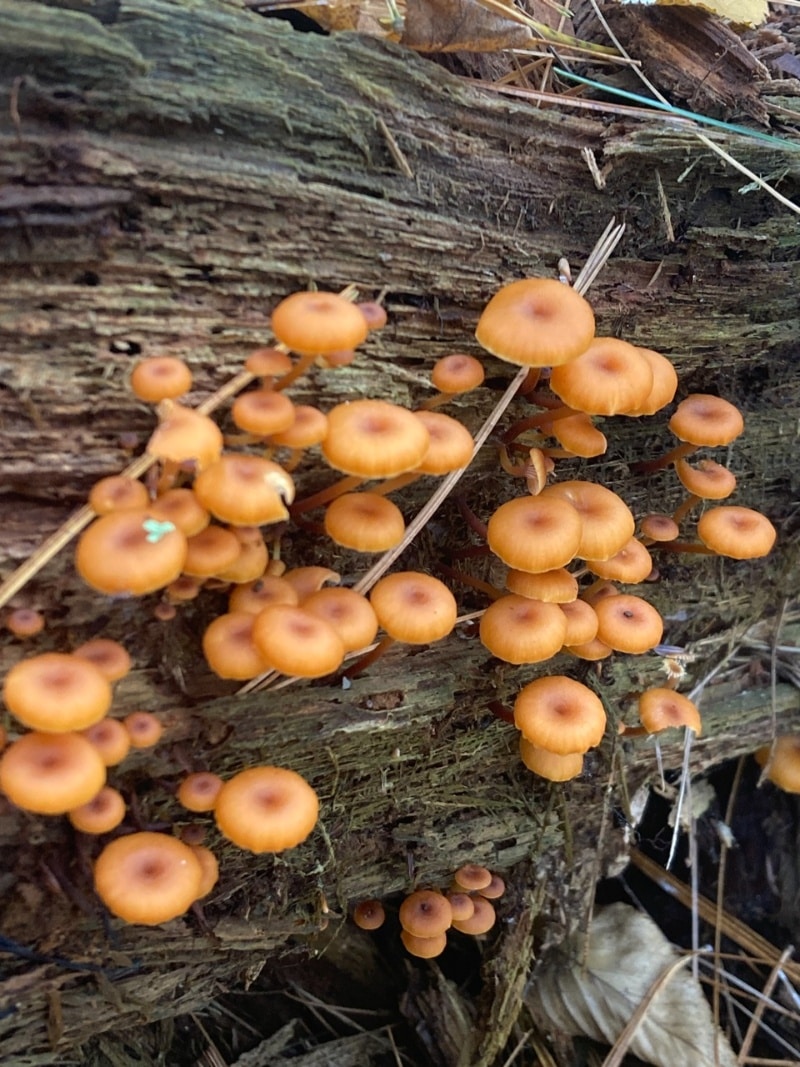
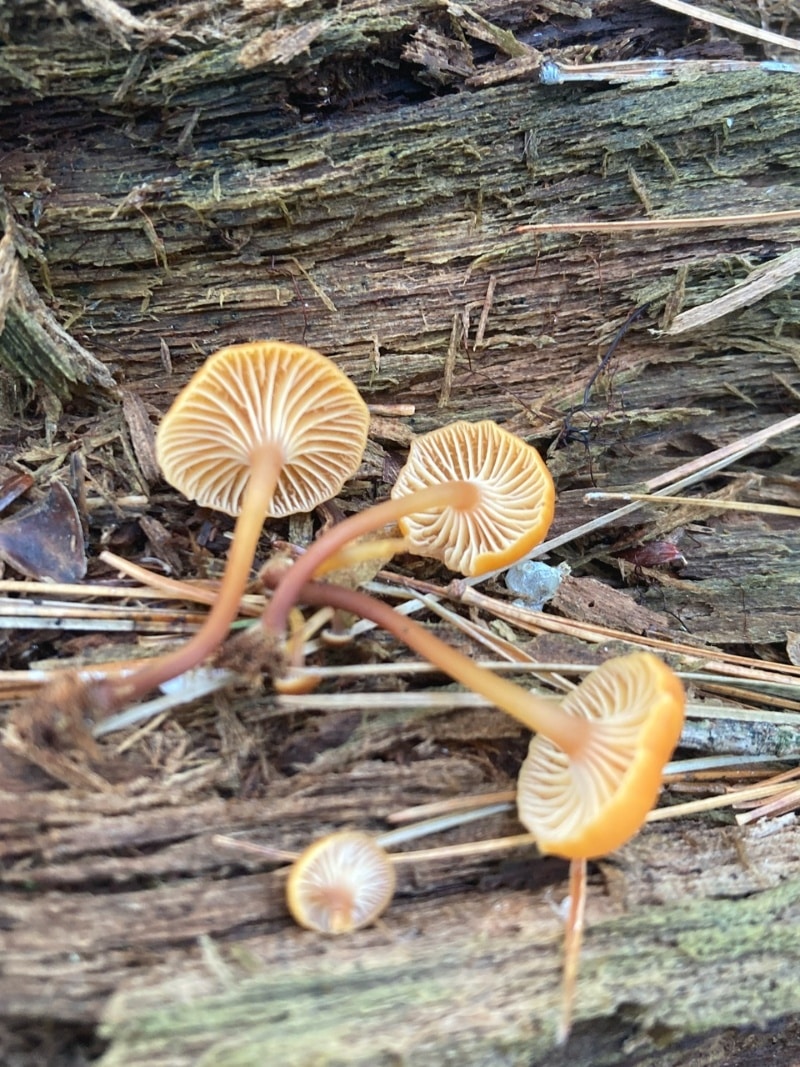
Xeromphalina kauffmanii
*this species looks identical to X.campanella (described above), except it fruits on hardwood
The caps of Xeromphalina kauffmanii are only 0.2-0.8 inches across. The cap begins bell-shaped but develops a distinctive deep central depression. It is brownish yellow to orangish brown but often fades with age. The edges of the cap are lined or pleated.
Gills on this species are pale yellow and run slightly down the stem. There are usually many cross-veins. The wiry stem is 0.4-1 inch long and very thin. It has a distinctive two-toned coloration: rusty yellow above and darker brown below.
This mushroom typically grows in dense clusters, sometimes by the hundreds, on hardwood stumps and logs throughout eastern North America. It has a white spore print and lacks any distinctive odor or taste.
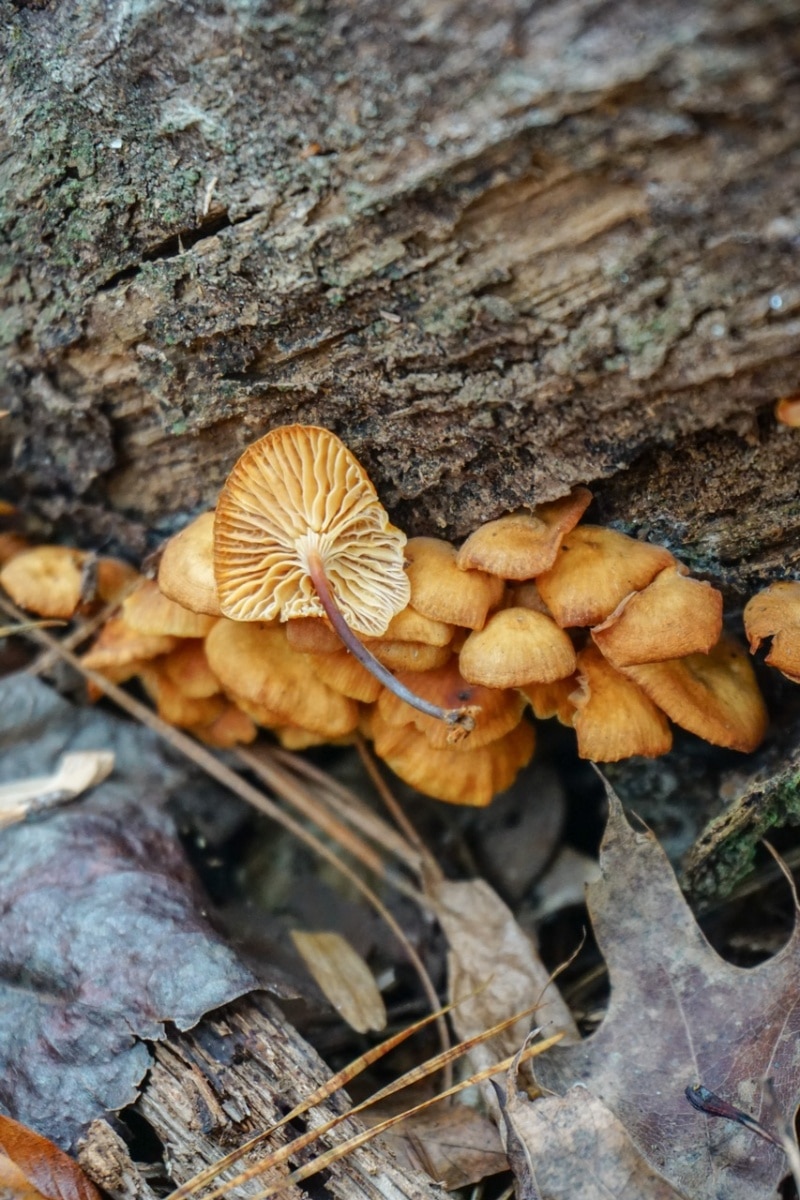
Xeromphalina cauticinalis
This Xeromphalina has small, convex to flat yellowish to orange-brown caps measuring 0.2-1.0 inches in diameter. It often has a darker center and occasionally develops a shallow depression. The cap surface is bald and can be tacky to dry. Sometimes, the cap is lined at the edges.
It has pale yellow gills that are broadly attached to the stem or slightly run down it and have noticeable cross-veins. The tough stem is slender and 0.5-1.2 inches long. It is yellowish near the cap and reddish-brown or dark brown toward the base. The bottom of the stem is covered with orangish to rusty brown hairs.
This mushroom typically grows gregariously in troops on conifer debris, but it may also grow in smaller groups or alone. It is most common on the west coast in summer and fall. It also does occur in northeastern North America but is less frequent. This species has a white spore print and indistinct smell and taste.
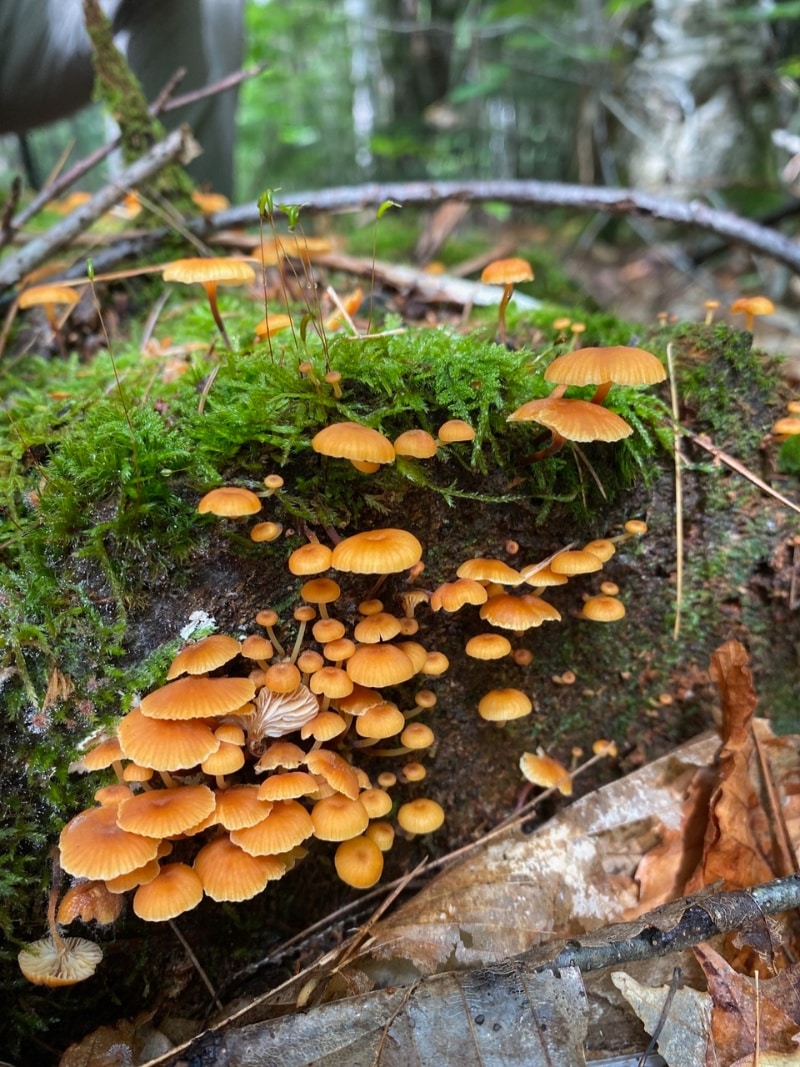
Heimiomyces tenuipes (previously Xeromphalina tenuipes)
Xeromphalina tenuipes has small to medium-sized caps that grow up to 1.2 inches in diameter. They are rusty to orange-brown with a smooth or slightly fuzzy surface. When it is young, there are vertical lines along the cap edge.
The gills are cream-colored to pale yellow. They are distantly spaced and connected by cross-veins on the cap’s underside. The stem grows up to 1.6 inches long and is dark orange to date-brown. It is covered in very fine, fuzzy hairs.
This species grows in small clusters or big troops on decaying wood. It grows on decaying hardwoods across eastern North America. It fruits in late spring to early summer. It does not have a distinctive smell and tastes bitter. The spore print is white.
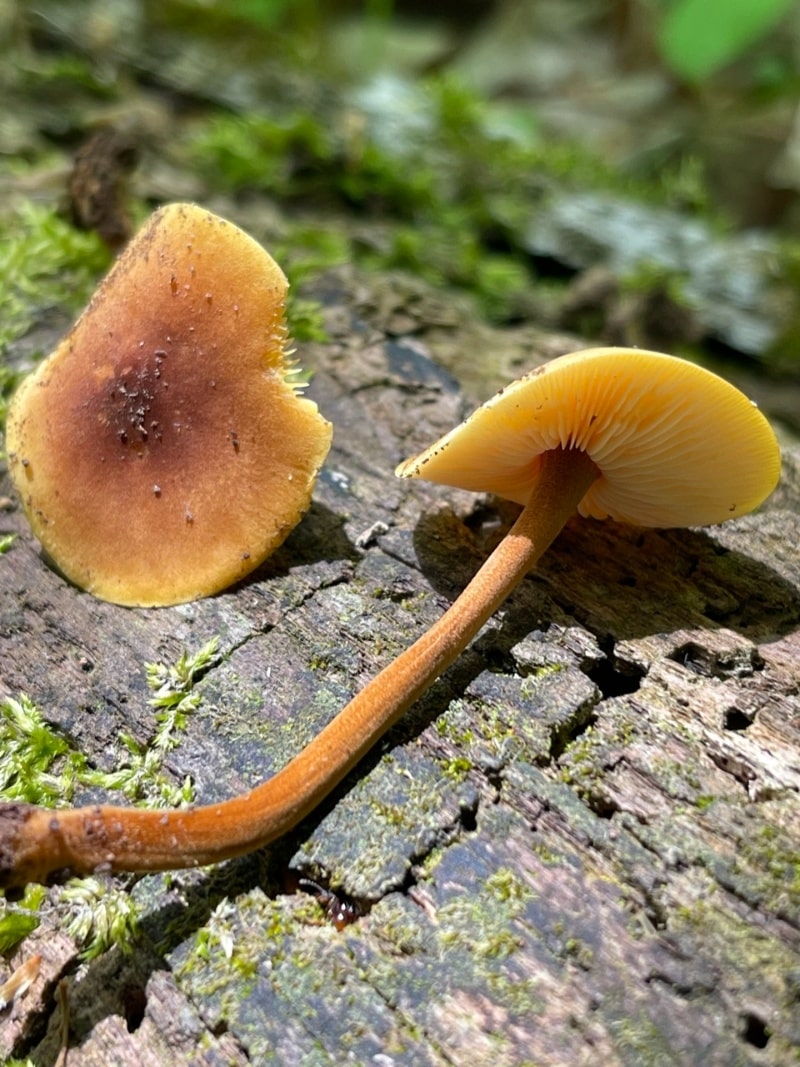
Xeromphalina brunneola
This species has a small, bell-shaped to depressed cap measuring approximately 0.2-0.8 inches in diameter. The cap is reddish-brown with a depressed center when mature and often has fine striations along the cap edge when moist.
Its gills run down the stem very slightly and range from pale yellow to pale orange. The slender, wiry stem is 0.6-1.2 inches long. It is yellowish near the top and transitions to a darker reddish-brown toward the base. The entire stem, or just the base of the stem, is covered in fine brownish hairs.
This mushroom grows in clusters on decaying conifer logs and stumps in western North America. It has a disagreeable odor and bitter taste. X. brunneola produces white spore prints.
Xeromphalina fulvipes (syn: Heimiomyces fulvipes)
Xeromphalina fulvipes caps grow 1-2 inches across and are bell-shaped to flat. The cap is bright yellow-brown, and the center is conspicuously darker. This species’ gills are distinctively adnate (they touch the stem but stop there). This is a key identifier because almost all the other species have slightly decurrent gills that not only touch the stem but run down it slightly. The gills are narrow to moderately broadly spaced and warm buff to brownish in color. They are often whitish when young, though.
The stem is slender and 0.8-3.1 inches long. It is tough and stuffed with tawny fibrils. The stem is rust-colored to blackish brown and covered with conspicuous fine and fuzzy zinc-orange hairs. At the bottom of the stem, the base has tawny-colored hairs that are often deeply buried in debris.
This species grows scattered or in small clusters on conifer debris (and sometimes on alder). It has a bitter taste.
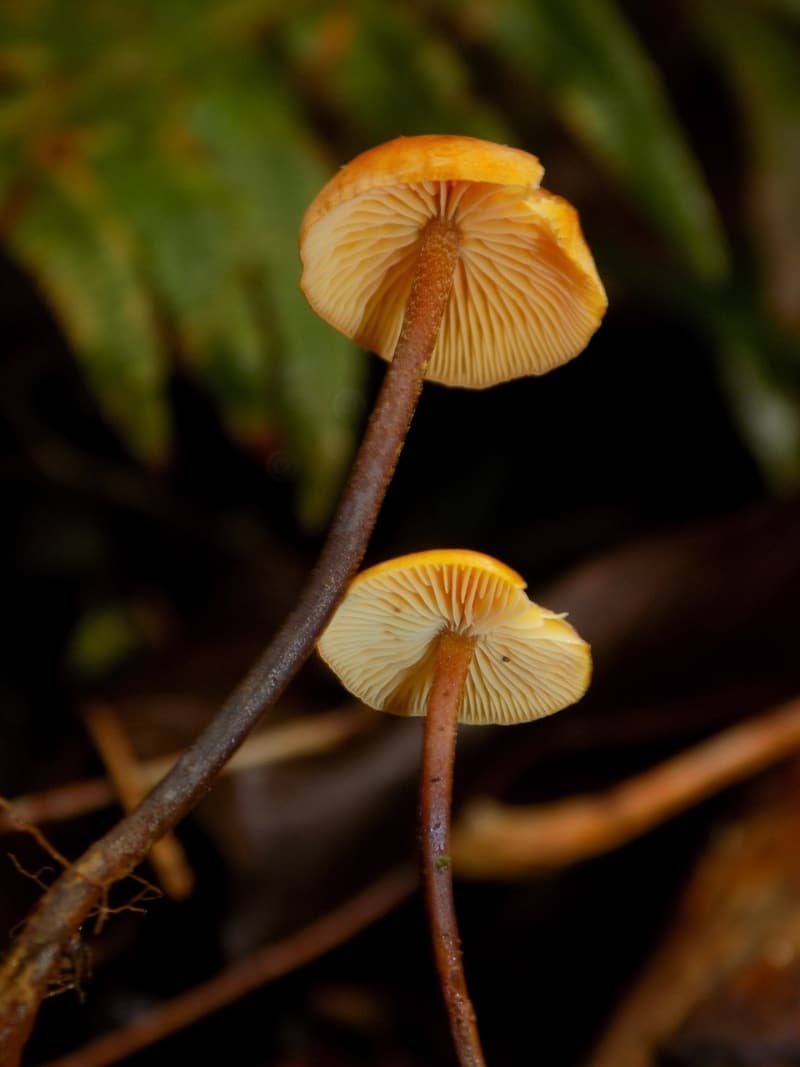
Xeromphalina cirris
The cap of Xeromphalina cirris measures 0.28-1.02 inches across. It is bell-shaped when young and then flattens out. The cap is hygrophanous (changes its degree of transparency depending on how much water it has absorbed) and distinctly orange to yellow-brown at the center. The edges of the cap fade to deep chrome or orange and may be almost translucent when wet.
Its gills are close to slightly distantly spaced, run slightly down the stem, and are light orange-yellow to orange-buff. The stem is slender and pale at the top and dark brown below. The stem is dry and covered with orangish hairs, but it may become bald with age.
X. cirris typically grows on conifer needles, most commonly in mountainous regions, particularly in alpine and subalpine zones. It is found in the Pacific Northwest and California. This species has a mild taste, which helps distinguish it from similar bitter-tasting species.
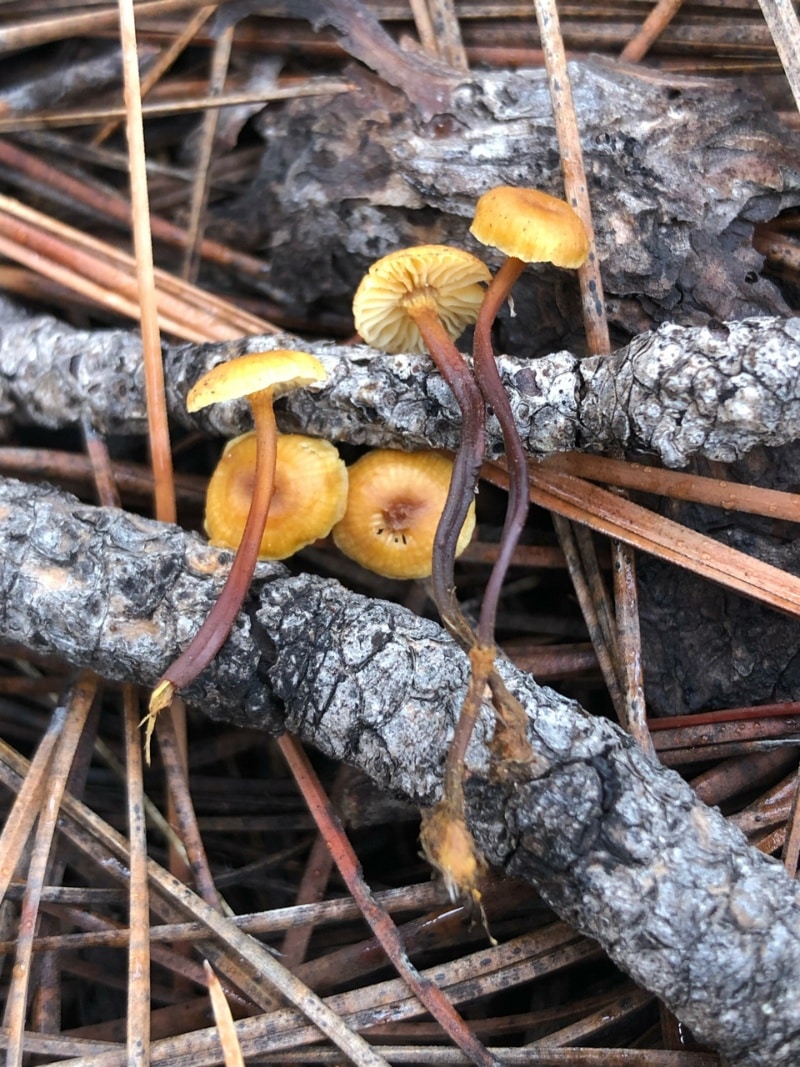
Quick Guide to Telling the Xeromphalina apart
If you are determined to figure out which species you’ve found, start with a few basic questions. First, is it growing on conifer or hardwood. That will quickly separate out the options. Second, where is it located, east or west of the Rocky Mtns. That will also narrow down the choices. Then, you’ll have to get into the more intricate details, like cap color and taste.
- Xeromphalina campanella group – Grows on conifers, orangish cap, 2-tone gradient stem color, mild taste
- Xeromphalina kauffmanii – Grows on hardwoods, orangish cap, 2-tone gradient stem color, mild taste
- Xeromphalina cauticinalis – Grows on conifer litter, yellowish-orange cap, 2-tone gradient stem color, more common on the West Coast
- Xeromphalina tenuipes – Grows on hardwood, rusty to orange-brown cap, dark stem covered in fuzzy fibers, grows primarily on the East Coast
- Xeromphalina brunneola – Grows on conifers, darker orange-red cap, 2-tone gradient stem color, bad taste (but not bitter), primarily grows on the West Coast
- Xeromphalina fulvipes – Grows on conifers, yellow-brown cap with darker center, gills do not run down the stem, cap not depressed
- Xeromphalina cirris – Grows on moss and conifer needles, yellowish cap with a darker center, stem usually covered in hairs, found in the PNW and California
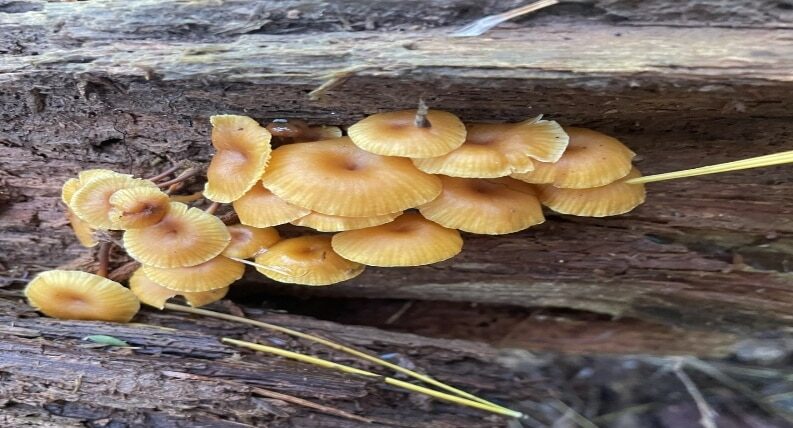
Xeromphalina campanella by Remington24 on Mushroom Observer
Common Lookalike Species
Many mushroom species look similar to Xeromphalina. But, as you read through the lookalikes, you’ll find that there are pretty easy ways to tell the differences. From afar, they all look like small parasol-like mushrooms, but just check one or two points, and you’ll know if it’s Xeromphalina or not.
Marasmius
Marasmius species, like the fairy ring mushroom, look similar to Xeromphalina with smooth, small, bell-shaped caps. They also have thin, tough stems like the Xeromphalina species. Marasmius mushrooms, though, often have deep radial grooves in their cap, called pleats, that separate it into sections. They also grow on leaf litter, pine cones, and twigs. These mushrooms often fruit in groupings, but not usually as robust ones as Xeromphalina species.
The other key differences are that Marasmius species gills may or may not attach to the stem, they are always widely spaced, and they do not have the cross-veins of Xeromphalina.
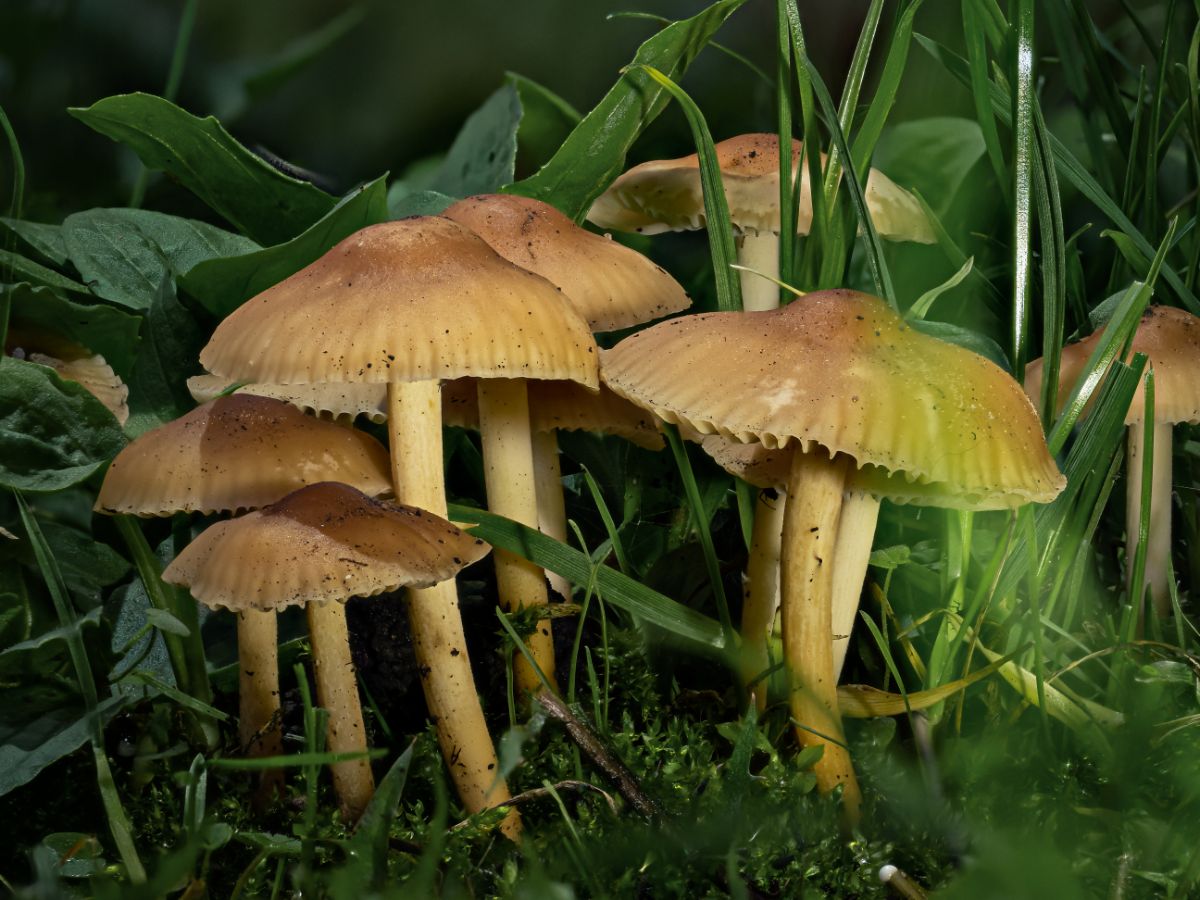
Mycena
Mycena and Xeromphalina mushrooms are both small, but they differ notably in several characteristics. Mycena species, like the orange mycena, are typically more delicate. They have cone-shaped to bell-shaped caps and slender, hollow stems. Xeromphalina stems are much tougher even though they’re the same slenderness. Mycenas come in many colors, including white, gray, brown, pink, and even bright orange-red. Their gills are typically attached to the stem, and they lack the distinctive cross-veins seen in Xeromphalina.
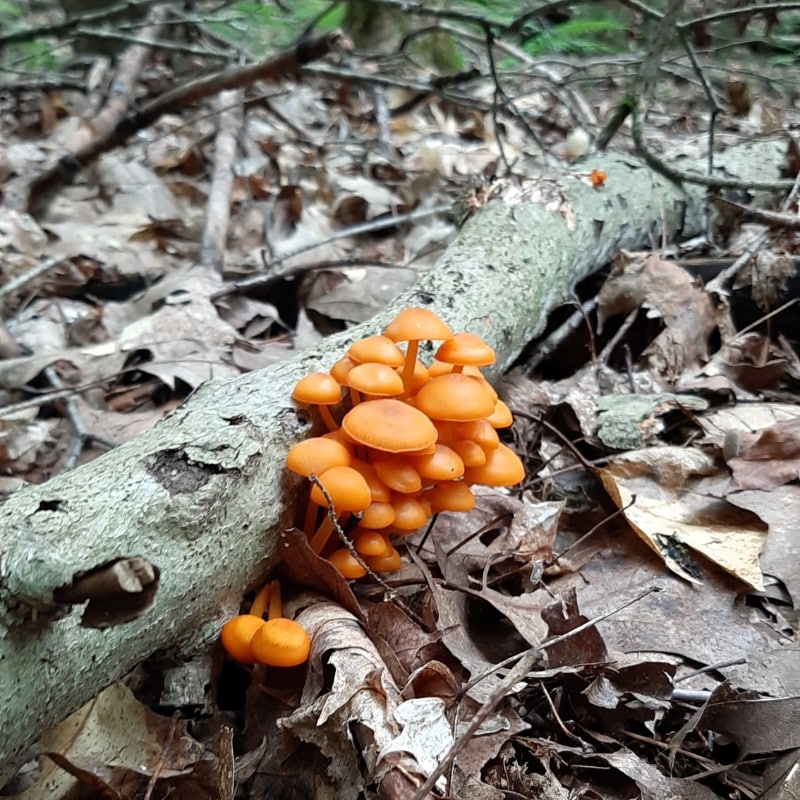
Parasola
Parasola species have delicate, umbrella-like caps that are often translucent, allowing you to see the gill pattern through the cap. These small mushrooms typically grow in grassy areas. Xeromphalina mushrooms, by contrast, are more robust and grow predominantly on decaying wood or forest debris rather than in open grassy areas. Parasola species are ephemeral and often appear after rain and then quickly disappear. Xeromphalina mushrooms tend to be more persistent.
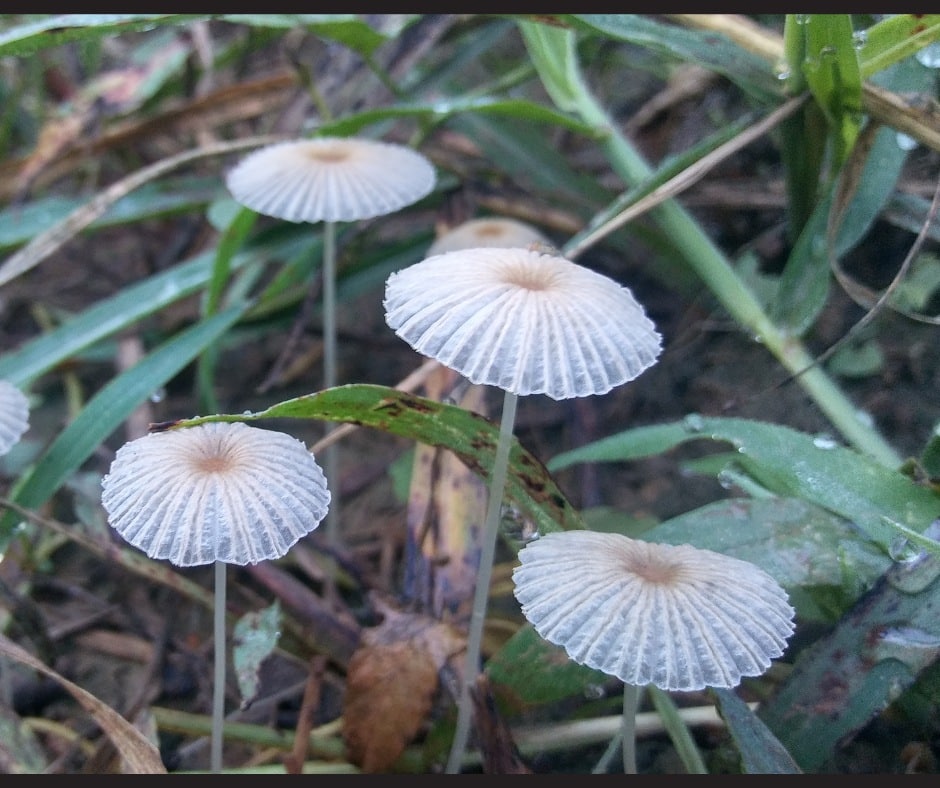
Rickenella
Rickenella and Xeromphalina are both small mushrooms with some similar features but several key differences. Rickenella species have tiny caps and are umbrella or funnel-shaped. Many Rickenella species are brightly colored and won’t be mistaken for Xeromphalina, but there are some that are orangish and can cause confusion. The primary difference is where and how they grow. Rickenella is a moss-dwelling mushroom that grows solitary or scattered. It doesn’t usually fruit in such incredible numbers as Xeromphalina species.
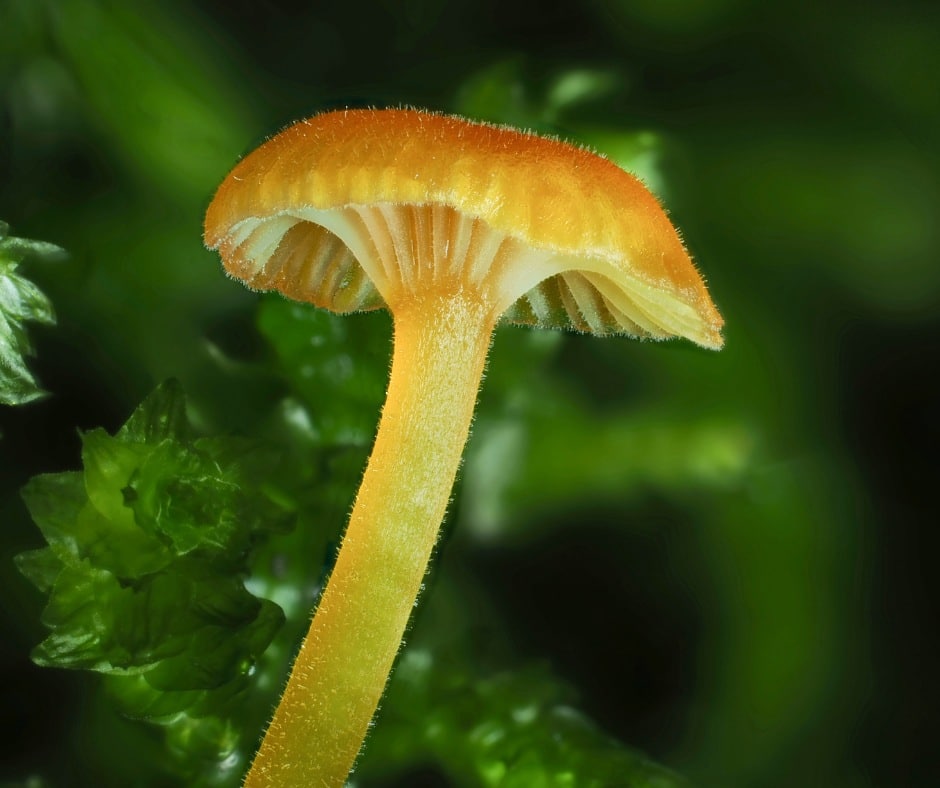
Contumyces
Contumyces and Xeromphalina are both small mushrooms with several notable differences. Contumyces species grow primarily in mossy or grassy habitats on silty or sandy soils rather than on wood.
Rhizomarasmius
Rhizomarasmius are small, like Xeromphalina, but they have grayish-yellow to olive-brown caps. Their stems are notably longer, making the mushroom quite tall compared to its cap size. These mushrooms don’t grow on decomposing wood like Xeromphalina. Instead, they grow on the rhizomes of flowering plants and ferns.
False Chanterelle (Hygrophoropsis aurantiaca)
The false chanterelle mushroom shares the same colors as the Xeromphalina species. In spite of that, you can easily tell them apart because H.aurantiaca is much bigger and has more defined gills.
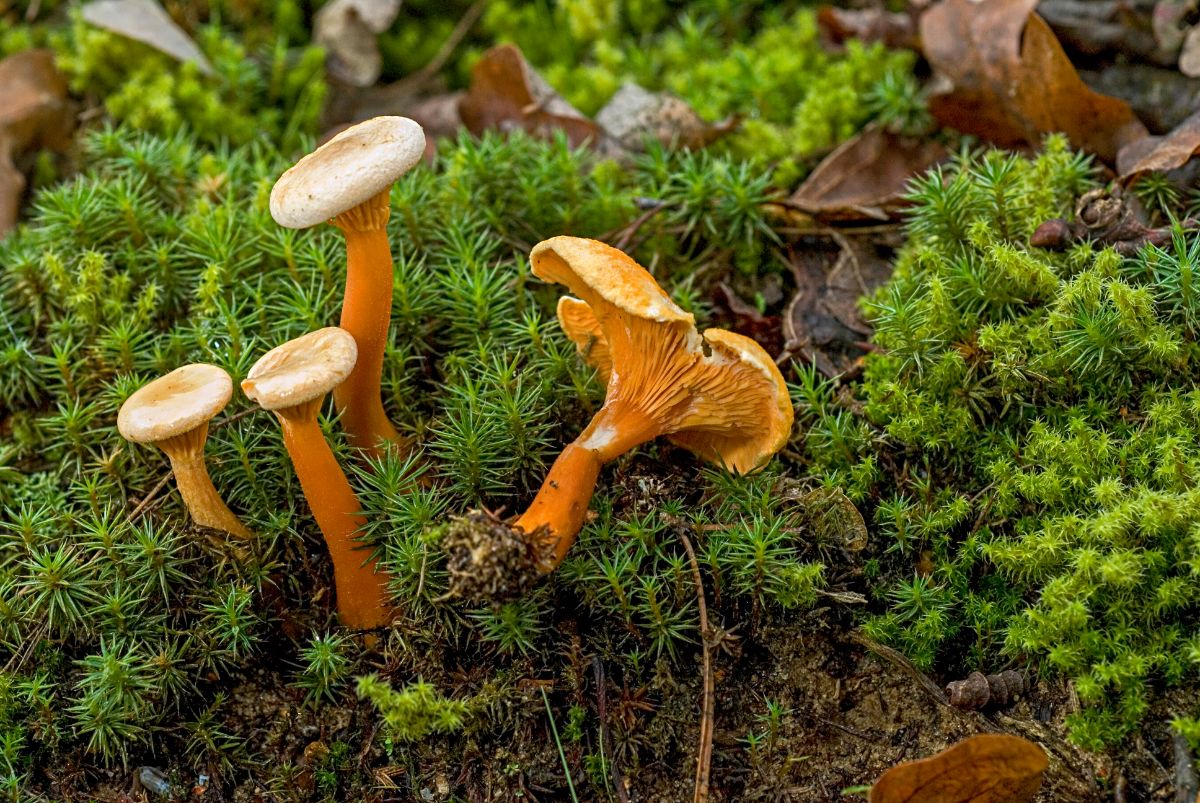
Yellowfoot (Craterellus tubaeformis)
The yellowfoot and Xeromphalina mushrooms are both small fungi that can be found in similar forest habitats. Yellowfoot mushrooms have funnel-shaped caps that are brownish to yellowish-brown. Its stem is bright yellow and hollow, and the false gills are thick, chunky, and widely spaced. These false gills may extend down the stem and often fork near the cap’s edge.
Xeromphalina mushrooms are generally smaller than yellowfoot mushrooms. While both species can be yellowish, Xeromphalina has true gills rather than the false gills or the wrinkles characteristic of the yellowfoot. Another key difference is that Xeromphalina typically grows directly on decaying wood in dense clusters. Yellowfoot can grow from both soil and rotting wood in conifer forests.
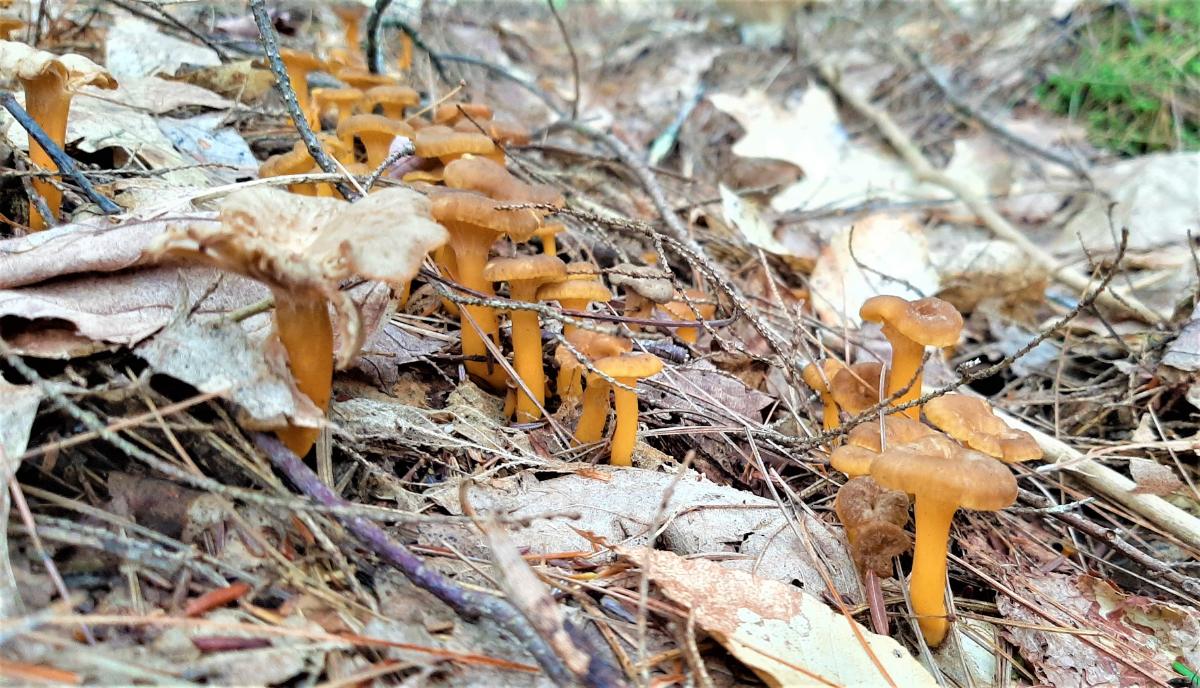
Xeromphalina Medicinal Properties
Scientists have found that X. junipericola contains xerocomic acid, which is an HIV-1 IN inhibitor.
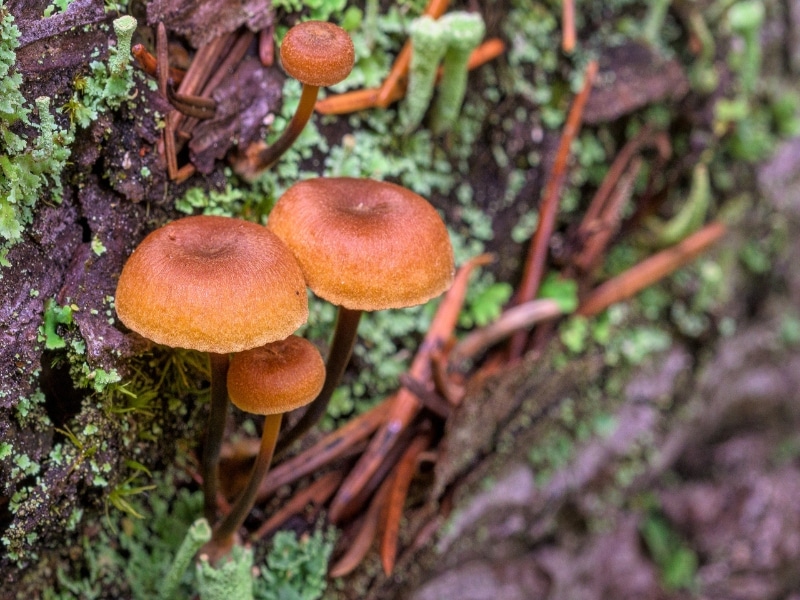
Xeromphalina campanella group by MtnMisfits on Mushroom Observer
Common Questions About Xeromphalina Mushrooms
Are Xeromphalina mushrooms safe to eat?
While Xeromphalina species are not poisonous, they are generally not considered edible due to their small size, often bitter taste, and tough texture. They have no culinary value.
When is the best time to find Xeromphalina species?
Most Xeromphalina species fruit abundantly from summer through autumn, with peak activity typically occurring from July through September. Some species, like X. campanella, may appear nearly year-round in warmer climates.



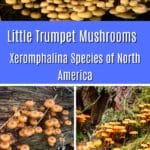

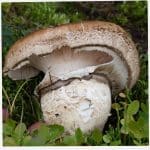
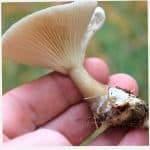

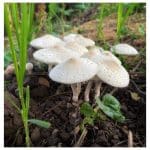
Leave a Reply